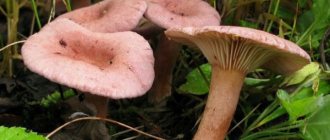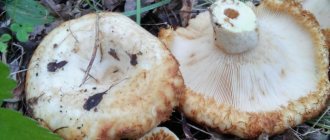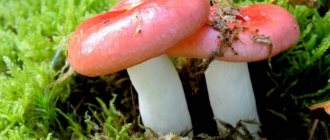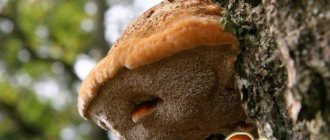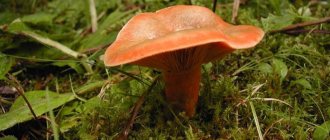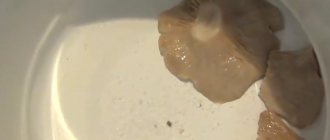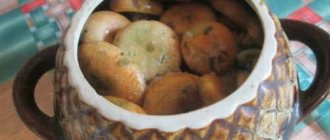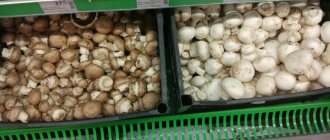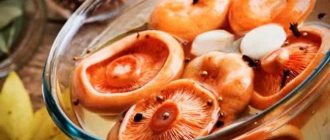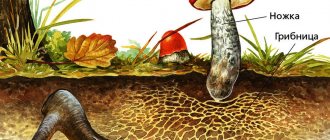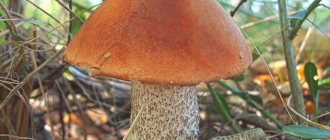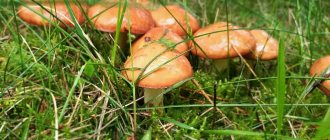Saffron milk caps
Rizhik, thanks to its taste and appetizing appearance, is deservedly considered one of the best mushrooms of the Russula family. You can find several species in the forests and, having spotted any of them, you need to hurry up and collect delicious orange mushrooms, since they quickly become worm-like and age, crumbling into dust.
These mushrooms got their sonorous name not only for the bright color of their skin, but also for their inherent carrot-orange color of milky juice.
Main types of saffron milk caps
Pine mushroom (Lactarius deliciosus)
Pine mushroom (Lactarius deliciosus)
It grows in pine forests and mixed forests, is found more often than others, and is distinguished by the reddish-red color of the fruiting bodies and the strong, stocky appearance of the mushrooms. The orange-yellow cap is round, 5–18 cm in diameter, with dark concentric zones, initially convex, over time the edges rise, forming a wide funnel. The hat is slippery to the touch and sticky in rainy weather. The plates are frequent, narrow, yellowish. The height of the hollow leg is up to 9 cm.
At the break of the pulp, an orange, milky, sweetish juice emerges with a pungent taste and smell of resin, which quickly turns green in the air. When removed, the mushroom acquires a slightly greenish tint, especially in places where it is touched.
The pulp is dense and when pickled, these mushrooms look very attractive.
Spruce mushroom (Lactarius deterrimus)
Spruce mushroom (Lactarius deterrimus)
Spruce mushrooms form mycorrhiza with the roots of spruce trees and grow only near these trees. The color of the cap is light orange, with darker rings and spots, and over time it acquires a dark green, coniferous hue. Under the sun, the skin tends to fade and become whitish. The stem is thin, 3–7 cm high, brittle, the cap is fragile, especially at the edges, which is why spruce trees often wrinkle and break in baskets.
Milky reddish juice is released in large quantities, it tastes good, and turns green in the air. When salted, spruce trees are very tasty and fragrant, but acquire a dark, greenish-brown hue.
Red camel (Lactarius sanguifluus)
Red camel (Lactarius sanguifluus)
The species is widespread in pine and spruce forests, characterized by a dense cap of reddish-pink or orange color, up to 10 cm in diameter with folded edges and a depression in the center, without an adhesive coating. The flesh is light, with a pinkish tint and burgundy spots. The milky juice is rich red in color, darkens over time, acquiring a red-brown color.
The leg is strong, up to 6 cm high, narrows at the base, covered with a characteristic powdery coating and small crimson pits over the entire surface. The color of the leg varies - from yellow-orange to purple. The species is edible, suitable for pickling and preparing a variety of mushroom dishes.
Milky red camel (Lactarius semisanguifluus)
Milky red camel (Lactarius semisanguifluus)
This beautiful bright mushroom is found near pine trees. The cap is fleshy, up to 9 cm in diameter, flat, with a slightly depressed center and folded edges. The skin is light orange, pink at the edges, and over time a greenish tone appears at the center. The plates are frequent, narrow, orange in color with a characteristic pink tint; in an aging mushroom they become reddish.
The milky juice is orange at first, then turns red and green. The taste is pleasant and soft. Hollow leg up to 7 cm high, narrow, fragile. The pulp is brittle, orange, and turns greenish when broken.
Characteristic
Despite the wide variety of chanterelle species, all these mushrooms are very similar to each other. Therefore, you can see what the common chanterelle mushroom looks like, and you will have a good orientation. Although beginners on their first trip are still recommended to take an experienced mushroom picker with them. This will be much more interesting, more educational, and safer. It is advisable to take at least a photo of the fox with you for clarity.
Characteristics of the common chanterelle
Characteristics of the common chanterelle
Let's take a closer look at what the chanterelle mushroom and its component parts look like.
Mushroom dimensions
The mushroom is quite small: the diameter of the cap rarely exceeds 10 cm, the height of the stem is between 4–6 cm, and its thickness is 1–3 cm. Depending on the species, they differ quite significantly. The largest specimens grow in the cockerel, the smallest in the tubular one.
hat
In young mushrooms, the upper part is slightly convex, but with age it becomes concave and funnel-shaped. The edges are sinuous and wavy. The spore-bearing layer is lamellar, passing onto the stalk. The gills are sparse, 1 cm less than 10. Some of the plates grow as if from nowhere and end “nowhere,” that is, they are not attached to either the cap or the leg. The color of the surface part ranges from pale yellow to golden-red in the common chanterelle. And from cream to light brown in the tubular one. The film is sticky and does not separate from the cap.
Pulp
The fruiting body of chanterelles is dense and white. The ordinary one has fibrous and fleshy pulp. It turns slightly red when pressed. The aroma of fresh mushrooms is fruity, and the taste is slightly sour.
Leg
In most species, the stem is hollow or tubular and slightly paler than the cap. The length depends on the diameter of the cap - they are approximately the same. The thickness is usually from 0.5 to 4 cm.
How long can chanterelles be stored fresh?
Where and when do saffron milk caps grow?
Saffron milk caps of all types prefer coniferous forests, but can also grow in mixed plantings under pine or spruce trees. Favorite places are forest edges, forest clearings, clearing areas, young spruce and pine forests. These mushrooms are most often found in the northern regions, forests of the Urals and Siberia.
Finding saffron milk caps can be difficult - they hide in groups under fallen soft pine needles, in dry weather there are almost no of them, and after drizzling summer and autumn rains they suddenly appear en masse, raising their shelters of pine needles and grass, highlighting a warm orange color to match the color of pine bark.
Harvesting begins in July, the main harvest falls in August and lasts until September. Experienced mushroom pickers notice where orange mushrooms grow and after each rain they collect fragrant forest harvests again and again.
The use of chanterelles in cooking and medicine
As mentioned above, chanterelles have a pleasant, delicate and aromatic taste. Children especially adore them. And adults are not averse to enjoying mushroom dishes. They can be salted, boiled, pickled, fried, baked, stewed, and so on. The number of dishes that can be prepared with this ingredient is simply crazy. There is even a separate article dedicated to this topic on our website – I recommend you read it.
The use of chanterelles in cooking and medicine
Calorie content of chanterelles
The calorie content of chanterelles is 19 kcal per 100 grams, if we talk about fresh mushrooms. Whereas when cooked in any way, the energy value of mushrooms will only increase. Growth will depend on the cooking method. For example, boiled chanterelles have a calorie content of 25 kcal per 100 grams, but fried in oil already 69 kcal per 100 grams. Also, the number of calories depends on the ingredients used in the dish.
False saffron milk caps (doubles)
Saffron milk caps are valuable edible mushrooms of the Milky genus, which, when broken, secrete abundant orange-red milky juice. The advantage of this characteristic is that they cannot be confused with inedible and dangerous species.
However, due to inexperience, other, not so tasty and aromatic mushrooms of this genus, classified as conditionally edible, can be mistaken for the noble saffron milk cap.
Pink trumpet (Lactarius torminosus)
Pink trumpet (Lactarius torminosus)
It is characterized by white milky juice that does not darken in air. This mushroom grows in deciduous forests at the roots of birch trees and is more common in northern regions. In addition to the white color of the milky juice, the pink wave is distinguished by a soft pink cap with fringed edges turned down and whitish flesh at the break.
Eating pink salmon if it is not properly boiled or salted for less than 45 days can cause problems with the functioning of the stomach and intestines.
Large milkweed or papillary breast (Lactarius mammosus)
Large milkweed or papillary breast (Lactarius mammosus)
Another conditionally edible mushroom of the same genus, growing in coniferous forests, often on light sandy loam. It is distinguished by a grayish-brown dry cap and white milky juice that does not darken in air. The pulp is white, brittle; if you rub it between your fingers, you can smell a faint coconut smell.
This species is used for food after soaking and prolonged salting.
Fragrant milkweed (Lactarius glyciosmus)
Fragrant milkweed (Lactarius glyciosmus)
A small mushroom with a cap diameter of up to 6 cm, which is characterized by a beige or ocher color and rolled up edges. The pulp is light, the milky juice is white, does not change color, the smell is strong, coconut.
It is used as a spicy additive to other dishes and in pickled form.
How not to make a mistake!
You need to collect saffron milk caps very carefully so as not to confuse them with their poisonous and very similar counterparts, which cause severe poisoning.
When you press your fingers on a real saffron milk cap, green spots appear on it and a red sticky liquid appears; this does not happen with false saffron milk caps.
And you also need to keep in mind that only red saffron milk caps have doubles, while spruce saffron caps do not have them.
Beneficial features
The orange flesh of saffron milk caps is so brightly colored due to the presence of carotene or provitamin A, which acts as a powerful antioxidant, strengthens the immune system, reduces the risk of cholesterol plaques, and supports the barrier function of mucous membranes.
In addition, mushroom tissues contain B vitamins (thiamine and riboflavin), ascorbic acid and a whole group of minerals necessary for the body - iron, potassium, phosphorus and calcium .
In saffron milk caps, this natural treasure trove of useful substances, a natural, potent antibiotic, lactrioviolin , was found, which inhibits many harmful bacteria, including the tuberculosis bacillus. It is the presence of this antibacterial compound that determines the harmlessness of the mushroom, which can be eaten during mushroom hunting directly in its raw form, adding a little salt or lightly frying over a fire.
In the old days, red mushrooms were prepared very simply - wiped with a canvas cloth, they were loaded into cedar barrels, fumigated with juniper branches, and pickled directly in the forest, immediately after collection.
The satiety and nutritional value is due to the presence of easily digestible amino acids and as a source of protein, these mushrooms are comparable to the best varieties of meat. In terms of calories and energy content, they are superior to beef, poultry and even chicken eggs. Therefore, orange mushrooms are a desirable product on the table of vegetarians or during fasting.
Interesting facts about chanterelles
Here are some interesting facts about chanterelle mushrooms:
- in the forest they grow in the form of “Witch’s rings”;
- the chemical composition contains a substance that kills Koch's bacillus (the causative agent of tuberculosis);
- Chanterelles contain more vitamin A than carrots and many other ingredients;
- at high temperatures, a large number of vitamins are destroyed - this applies not only to chanterelles, but also to most other products;
- Every year in the USA there are competitions to find the most original dish using this ingredient;
- The largest chanterelles are registered in California, where the weight of these mushrooms can reach half a kilogram.
Recipes for cooking dishes from saffron milk caps
Knowledgeable mushroom pickers believe that real saffron milk caps should be eaten salted without spices , then they acquire an incomparable forest taste, taste of pine needles, and a slight bitterness of pine resin. Therefore, mushrooms are pickled immediately after collection, wiped with a clean cloth, placed tightly in a container and generously sprinkled with salt. These pickles are eaten after 10–14 days.
The need for rapid harvesting of saffron milk caps is justified not only by their excellent taste, like other mushrooms, it is a perishable product that should be processed as soon as possible.
Salted saffron milk caps with spices
At home you can prepare delicious savory mushrooms, which are obtained by cold pickling. To do this, for 1 kg of saffron milk caps, take 40 g of salt, a little bay leaf and black currant leaves, allspice and ground black pepper to taste.
The mushrooms are doused with boiling water twice, first poured onto a sieve, then doused with cold water and left to dry a little.
Place salt and spices at the bottom of the container, mixing them and spreading them in a thin layer. Then lay out the saffron milk caps, caps on top, in rows up to 7 cm thick, each layer is salted and peppered. Place all the remaining spices on top. The workpiece is covered with a piece of cotton fabric, a wooden circle, pressed down with pressure and taken to the basement. It is convenient to use a glass bottle of water as a pressure.
After a few days, brine appears and, if it is not there, the severity of the oppression is increased. Excess brine is drained if necessary. These spicy mushrooms can be eaten after a month, and the snack is stored in the refrigerator.
Baked marinated saffron milk caps
This delicious original appetizer will serve as an excellent decoration for the holiday table. And in terms of juiciness and forest aroma, it cannot be compared with any store-bought delicacies.
To prepare the marinade take:
- 1 liter of vinegar 3.5% strength;
- 20 g sugar;
- 20 g salt;
- 5–7 bay leaves;
- a little clove.
All components are mixed and brought to a boil.
Place the peeled saffron milk caps, washed under running water, on a baking sheet and place in a hot oven for 10–12 minutes. Then they take it out of the oven, cool it a little, put it in jars while still warm and pour it with hot marinade.
After this, the jars are sealed with plastic lids and, as soon as they have cooled, they are placed in the refrigerator. For long-term storage, canned food is covered with metal lids, sterilized for 30–40 minutes, and then sealed.
Saffron milk caps in sour cream
The classic mushroom dish turns out especially tasty when using saffron milk caps. To prepare, follow these steps:
- Finely chop the onion and fry until golden brown.
- Mushrooms are cleaned, washed, large ones are cut into halves, lightly sprinkled with flour and fried.
- Combine mushrooms and onions, add sour cream and heat until boiling.
The dish is salted, ground pepper, finely chopped dill and other spices are added to taste.
Taste qualities
Real saffron milk cap is an edible, healthy elite mushroom. Used fresh, boiled and fried. Most often used for salting and pickling. It is superior to other mushrooms in its rapid absorption by the body.
Ryzhiki can be baked in the oven.
Raw mushrooms
Since saffron milk caps do not require soaking, some gourmets eat them raw. It is safe for a healthy person. The saffron milk caps are cleared of debris, sorted and sprinkled with salt. For better salting, place under pressure for 20 minutes. The dish of raw saffron milk caps is ready!
Common saffron milk cap.
Fried or boiled mushrooms
A classic version of hot processing of mushrooms. Fried saffron milk caps are served as a separate dish or used as a filling for pancakes and pies. Boiled mushrooms are often used to make salads. Such dishes are not only incredibly tasty, but also very beautiful due to the bright red color of the product.
Salted and pickled mushrooms
For the winter, saffron milk caps are pickled or salted. To preserve the specific taste of this mushroom, it is better to treat it with salt rather than vinegar. Salted saffron milk caps have always been considered a delicacy on the table. To preserve the appetizing red color of mushrooms when pickling, it is recommended to first scald them with boiling water.
When pickling mushrooms, real saffron milk can itself be used as a seasoning. If you have a low yield for saffron milk cap, then you should not pickle this mushroom separately. It is better to prepare an assortment of mushrooms suitable for pickling. You can take kubari, milk mushrooms, and volushka. When you add real Rizhik, the whole pickle will be filled with the incomparable aroma and exquisite taste of this royal mushroom.
Characteristic differences
These two species have much more differences than might seem at first glance. To correctly identify a mushroom, you should familiarize yourself with the following features:
- The smooth caps of saffron milk caps are always red in color, while the saffron milk caps, with their shaggy caps, have a pink tint.
- The juice of saffron mushrooms is white, while in saffron milk caps it is carrot-colored.
- There are circles on the top layer of both types, but they are more distinct in the waves.
Milky sap from pine saffron milk caps - If you compare mushrooms of the same age, then saffron milk caps are larger.
- The cut site of the volnushka does not change color, but in the saffron milk cap it takes on a greenish-blue color.
- Volnushki are more often found in forests, because they are not so whimsical to their living conditions. Camelina can grow only in environmentally friendly places and always away from the roadway and dust.
- Cooked saffron milk darkens, and the volushka turns light gray.
Camelina is characterized by a funnel-shaped cap with smooth or slightly curved edges. The caps of the wavefish have a more spherical shape, and the edges are much rounded inward.
Ryzhiki are considered delicacies, because they have a rather pleasant taste. Before cooking, they should only be cleaned; there is no need for prolonged soaking.
Before cooking, the volushki should be soaked in water for a couple of days to remove the bitterness. During soaking, the water should be changed periodically. Only well-soaked milkweeds can be used for pickles, as there is a risk of food poisoning. After pickling, you should wait about two months, and only after that you can eat.
By the way!
The saffron milk caps can be used almost immediately, after washing and cleaning them first. These milkweeds can not only be salted and pickled, but also fried. Their composition, unlike tremors, contains a very small amount of chitin, which negates the benefits of the fungus.
Table
| Ryzhik | Chanterelle |
| The cap is slightly concave, its edges are smoother | The cap is strongly concave (in an adult mushroom), its edges are wavy |
| The plates and the leg are demarcated | The plates smoothly transition into the stem |
| Darker, circles and greenish spots are visible on the cap | Lighter |
| Smooth | Velvety |
| Brittle | Fleshy |
| Milky juice on the cut | Juice does not appear on the cut |
| Can be wormy | As a rule, not wormy |
